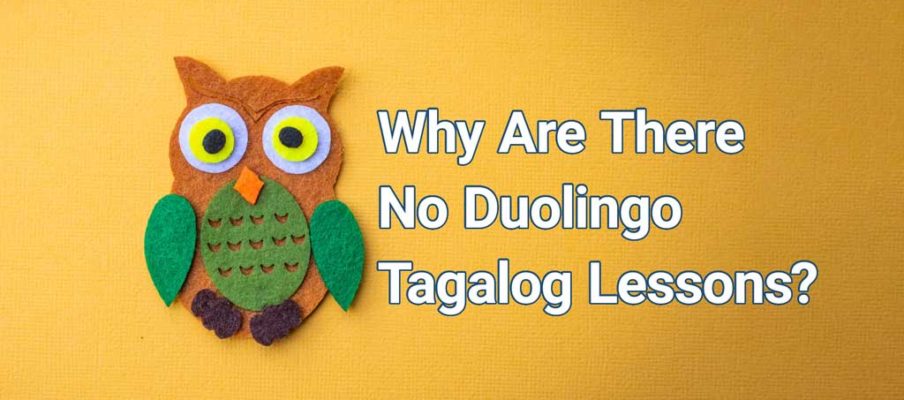Did you come across this article after googling “Duolingo Tagalog” or “Duolingo Filipino” or something like that? Probably you are checking whether Duolingo has a Tagalog course. Well, I’ve got good news for you and I’ve got bad news, too. Which one do you want first?
Let’s start with the bad news.
Most people like it that way. At the time of writing (July 2019) there is no Duolingo Tagalog. You would think a company like Duolingo, the most popular and perhaps the most advanced foreign language learning company in the world, would have courses for a language like Tagalog.
After all, Duolingo even has courses for invented fantasy languages like Klingon from Startrek and High Valerian from the HBO Series Game of Thrones.
Why wouldn’t it have a course for Tagalog, a language with something like 30 million native speakers and around 50 million second language speakers around the world?
There are lots of reasons why someone would like to learn Tagalog.
Definitely there are more reasons to learn Tagalog, which you can use in perhaps literally very country of the world (since there are Filipinos in every country in the word) than Klingon or High Valerian which you can probably use in Comic-Con.
So why don’t they?
The main reason is an economic one. You’ll be quite convinced of this if you listen to the interview of Luis von Ahn co-founder and CEO of Duolingo on the Tim Ferriss Podcast. As a business, Duolingo has to focus on the features and services which will benefit them the most.
There’s are big incentives for Duolingo to develop courses for languages like Spanish, Mandarin Chinese or French, since there are lot of people who who both study these languages, and these people are more likely to pay to upgrade their account to paid Duolingo Plus account.
What about languages like Hindi or Swahili that are quite widely-spoken as well?
There may not be as much economic interest in these languages but there’s a Duolingo course for Hindi and Swahili. What matters though are the number of learners of language willing to upgrade on Duolingo to paid Duolingo accounts, not the actual prevalence of the language.
Most people who visit the Philippine shores can attest that it isn’t hard to access and communicate with people that can teach you Tagalog. English is spoken almost everywhere in the Philippines and by most Filipinos. This reduces the incentive most Tagalog learners would have to cough up a few bucks extra to unlock the fancy premium features on Duolingo.
Perhaps another contributing factor is the convoluted grammar Tagalog has. Probably, someone took one look at a table of Tagalog verbs and their tenses and got physically sick.
This complex grammar makes planning out lessons complicated and time-consuming. Looking at it through a lens of pure business, time spend developing a course around Tagalog would be better spent optimizing their lessons on more popular languages.
Okay, I first gave you the bad news. Time for the good news.
Well, I have nothing against Duolingo.
If you check my phone I have Duolingo installed and on it is a wish list of more languages than I can master in my lifetime (Mandarin, Swahili, Hindi, Spanish, Russian, French, Japanese, Korean).
I love dabbling in foreign language learning way too much and Duolingo is my enabler. But hey, Duolingo is not the only way to learn Tagalog. There are are some really good resources to learn Tagalog which will really work on your Tagalog in some ways Duolingo can’t.
While Duolingo has advanced algorithms to make learning as interesting and efficient as possible, it only exercises your foreign language skills on a very narrow band in the spectrum of skills need to successfully speak a foreign language.
Most significantly, despite the app being very advanced, it does do whole lot in training a learner in listening comprehension which is the weakness of most language learning programs.
I’m not just going to stop at the good news. Here comes the better news.
The better news is that as a lifelong learner of foreign languages, and a native Tagalog speaker, I have come up with a website Talk Tagalog which features a whole range of lessons, using different formats and approaches.
There are videos with transcripts, podcasts, discussions on grammar, and all other sorts of stuff to entertain and educate the Tagalog learner. The lesson are mostly classified by difficulty to somewhat match your skill level.
Talk Tagalog even has a very popular newsletter which alerts you every time something really good happens (maybe once or a few times a year), like whenever we come up with a whole new batch of podcasts.
I realized that to develop real fluency in a language, you need a good foundation of listen comprehension and attack it from all angles.
However, Listening Comprehension should be the bread and butter of foreign language learning. It not only trains your ear to pick out the sounds and words, but it also lets you hear what you’ve been “studying” like formal lessons in context.
It’s easy to train yourself to recite speeches in Tagalog. However, it is plain good old listening comprehension that will allow you to talk to Tagalog speakers.
If there is good news, and better news, there is also what I call the best news.
The best news? Did I mention that Talk Tagalog is free?





Please add me to your mailing list. Thank you.
Correct link is https://duolingo.fandom.com/wiki/Course_contributor_guide